No time to island hop in Greece? Trust the hype and get to Nafplio! Everyone we spoke to about Greece and the Peloponnese had the same advice about this beautiful seaside city: you have to go! Nafplio is charming and historical, and it was a perfect way to spend our last afternoon in Greece.
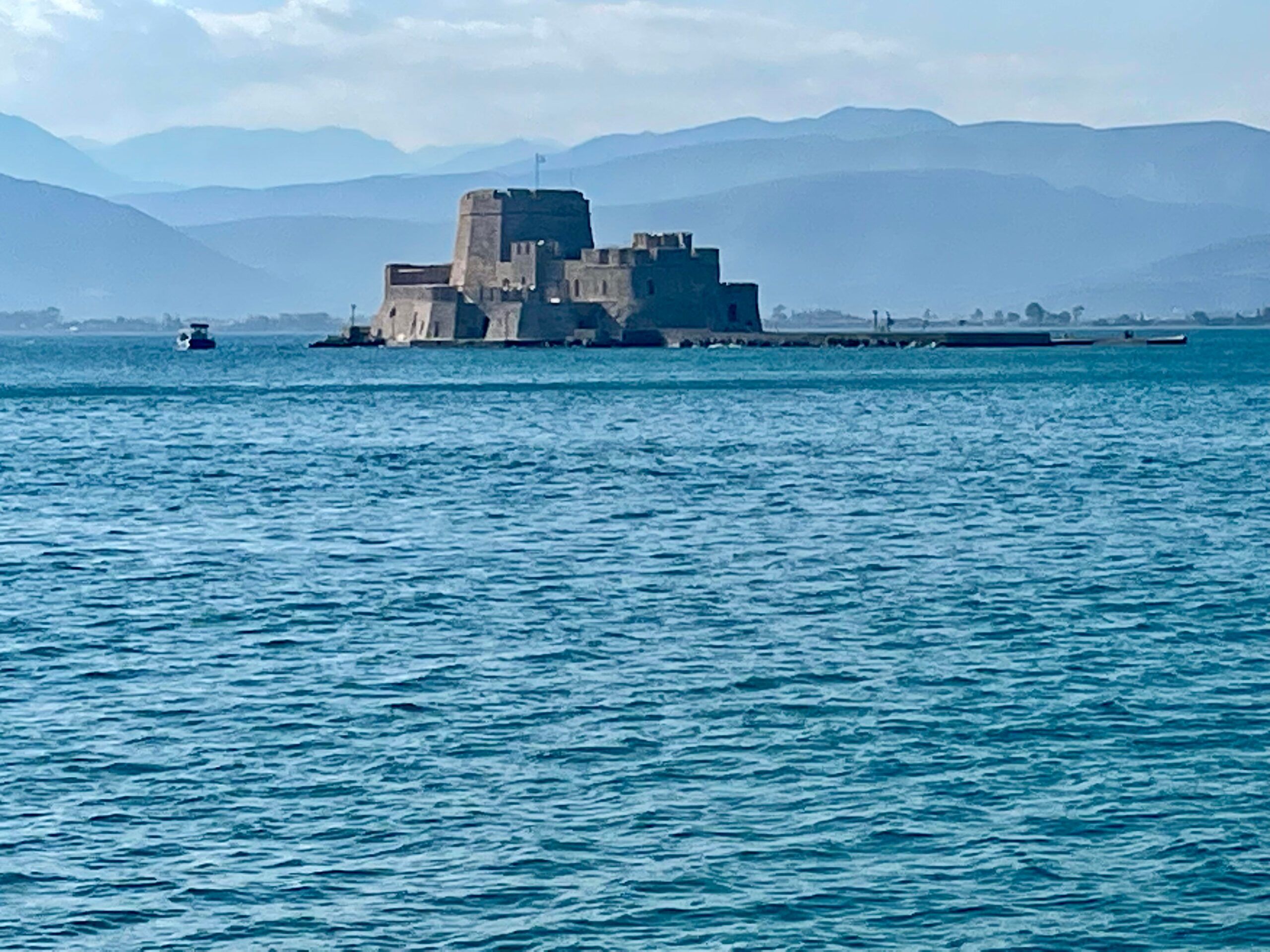
The Bourtzi Castle – The most photographed spot in the city
Although it was once a secret weekend retreat for Athenians, Nafplio has blossomed into a beloved (and now somewhat touristy) destination. We knew right away a “quick stop” here would not be enough.
Nafplio (also called Nafplion, Nauplia and Anapli) has plenty of options whether you want to speed up your heart rate or slow it way down. Some go for the fresh seafood, romantic atmosphere, and a relaxing weekend on the beach. You can also climb around in castle fortresses and get lost in cobbled alleyways filled with quaint shops and Neoclassical mansions.
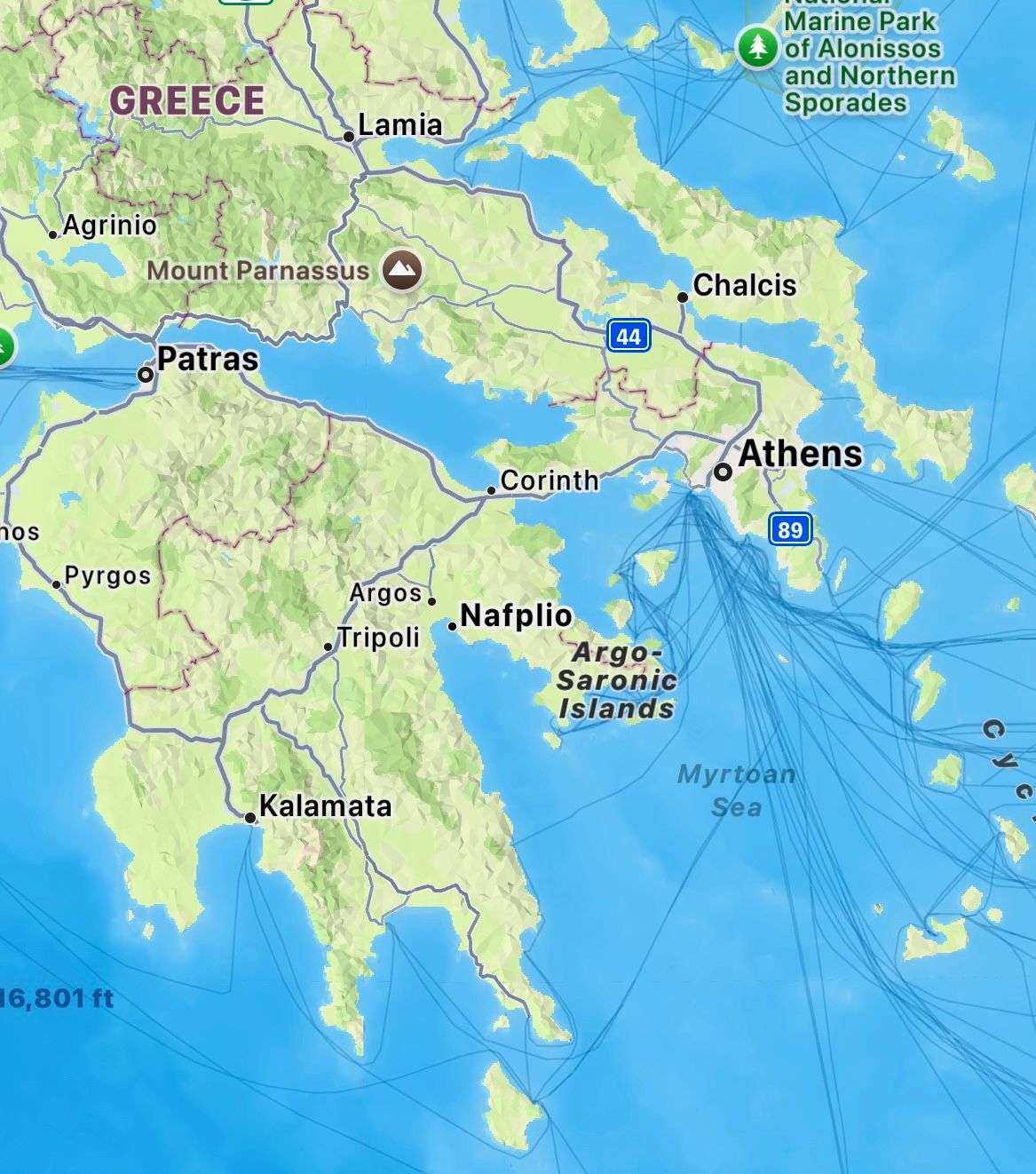
This small town in the eastern region of the Peloponnese has the feel of a Greek island. If you’re looking for sea views, sandy beaches, sailboats, beautiful sunsets, and activities for all ages, there’s no need to island hop.
TIP: Visitors can get to Nafplio in about 2½ hours from Athens. It’s also a perfect home base for visiting nearby archaeological sites and cities like ancient Corinth, Mycenae, Epidaurus, Sparta, and Nemea.
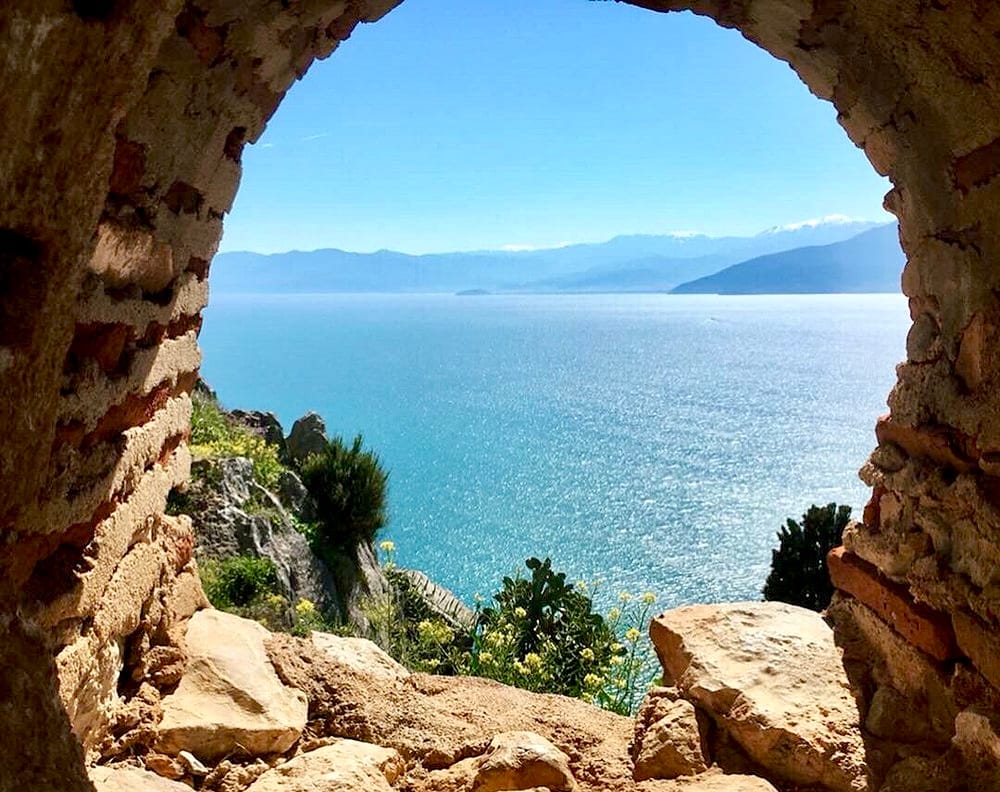
History and Culture Meet Seaside
Greek mythology tells us the city was founded by Náfplios, the son of Poseidon.
The town’s history goes all the way back to the prehistoric era of the Argonaut expeditions and the Trojan War (1400-1300 BC). Ancient warring Greek cities (like Athens, Sparta and Corinth) sieged, invaded, and occupied one another for centuries — continuously shaping the culture and landscape of Peloponnese cities like Nafplio.
In the 9th century AD, the city’s commercial seaport and acropolis began to catch the attention of many. Byzantines, Franks, Venetians and Ottomans took turns competing for Nafplio.
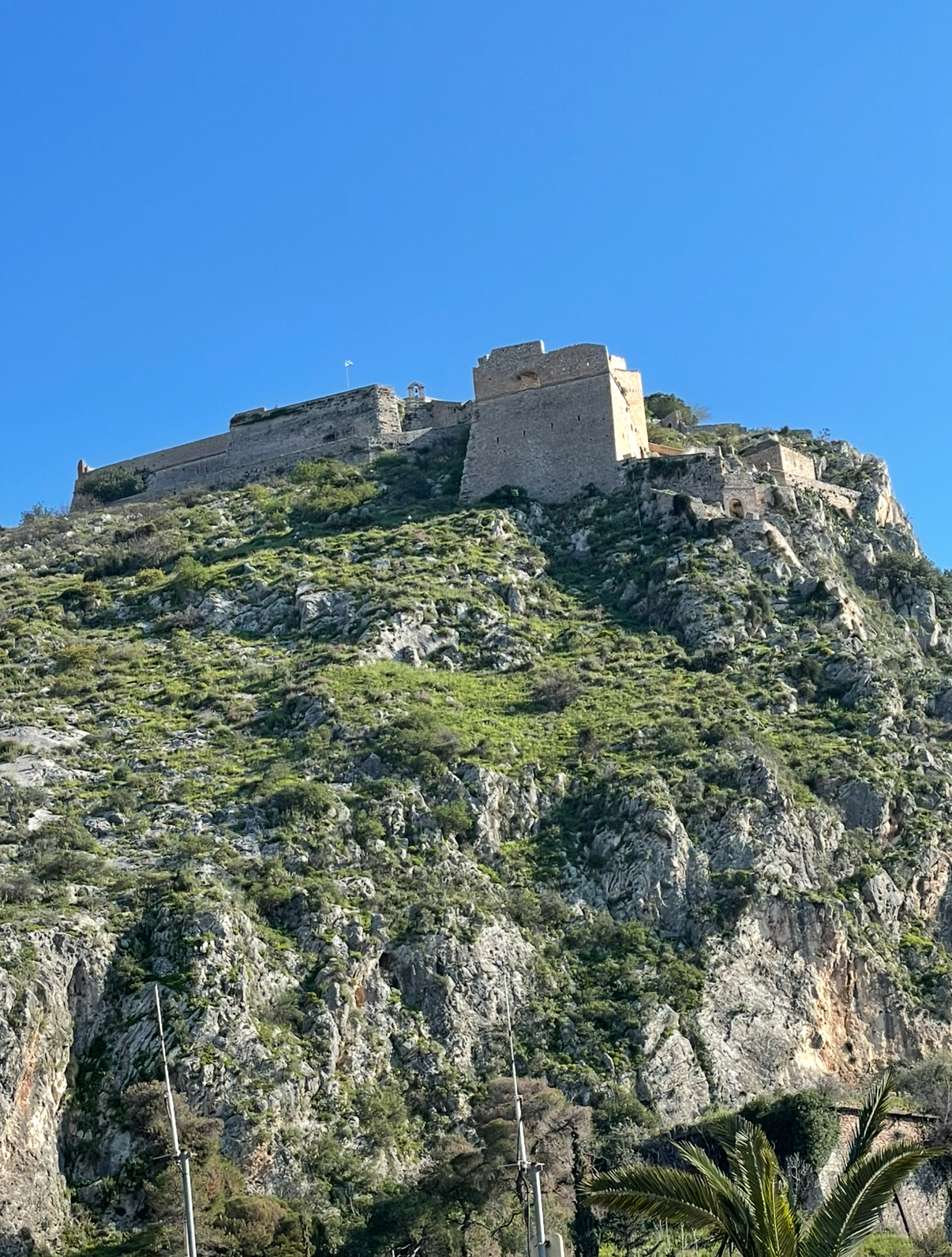
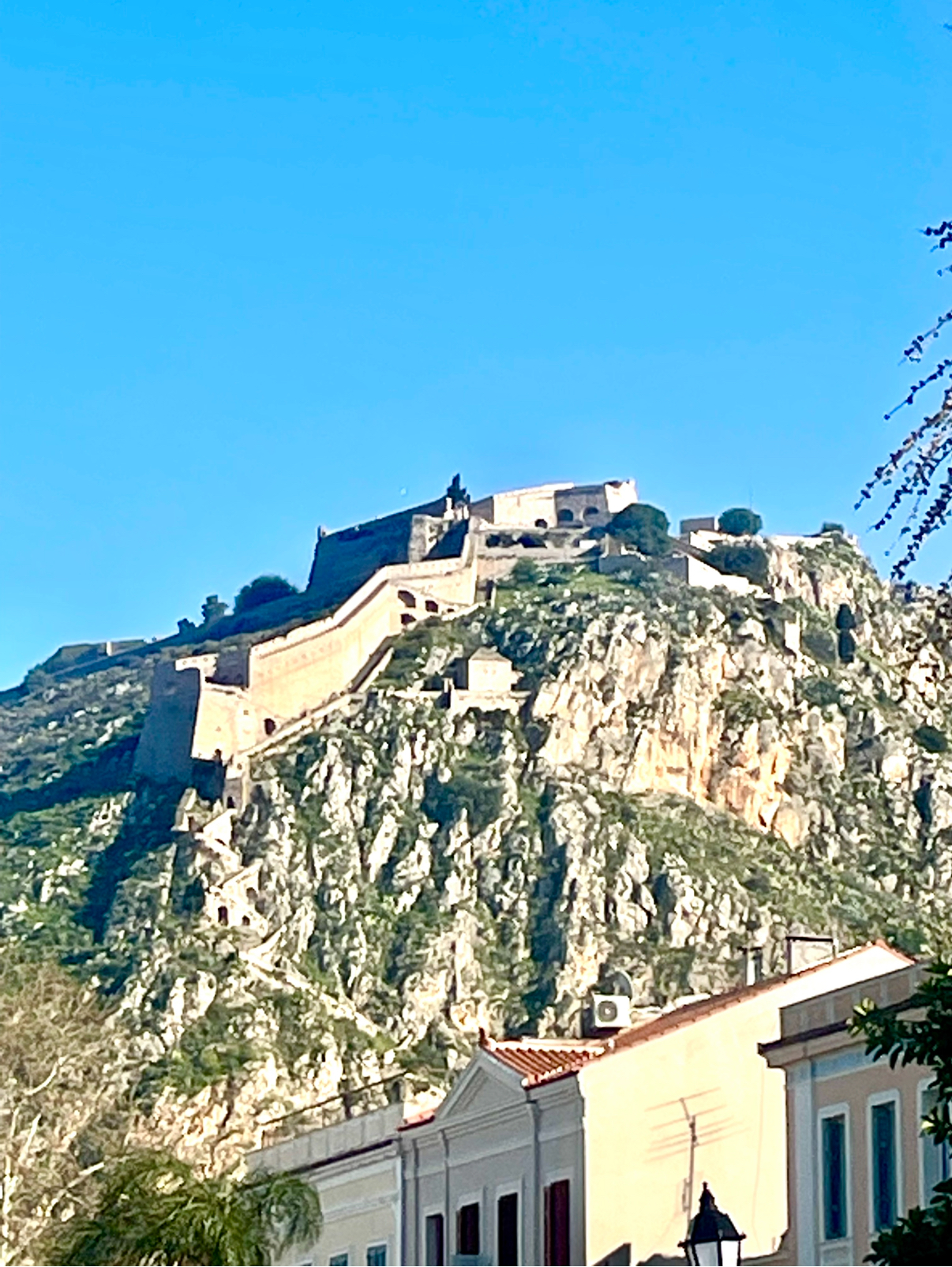
“Look Up” to see the many fortress walls guarding Nafplio and its harbor.
After Byzantines reigned, the Franks defeated the city in 1212 AD and controlled it until they sold it to the Republic of Venice in 1388.
Venetians then ruled Nafplio twice (1389-1540 and 1686-1715) in between being conquered by the Ottoman Turks. When Venetians were in control, they beefed-up defenses by building two more fortresses.
Despite Venetian safeguards, Nafplio fell to the Ottoman Turks in 1540 and again in 1715. The Turks dominated until the Greek War of Independence. They also undertook extensive construction projects and even added a series of unique Turkish fountains.
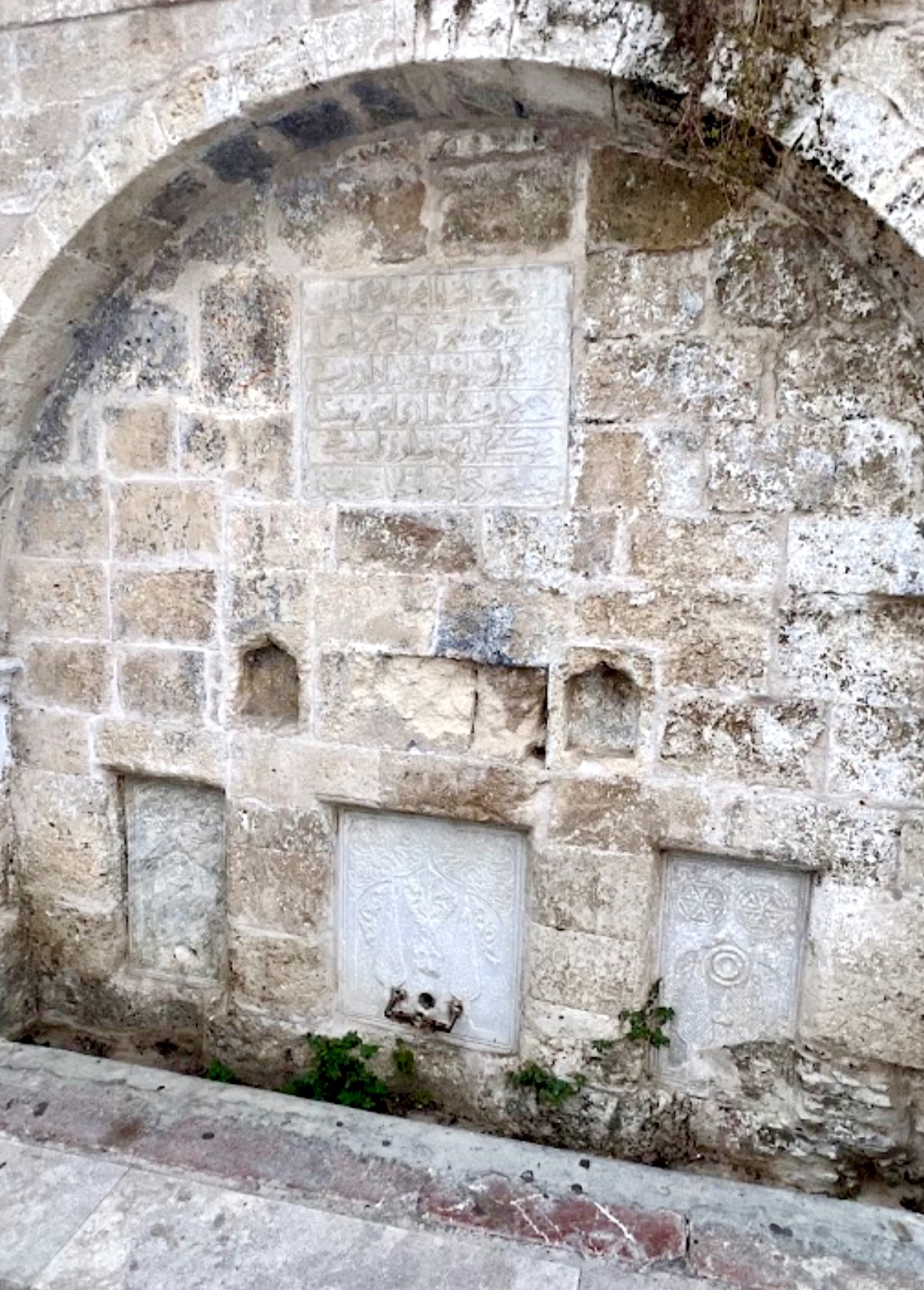
Ottoman fountains are now architectural landmarks in the Old City.
Nafplio might have lived in the shadows of its Peloponnese neighbors for centuries, but it was one of the first towns liberated from the Ottoman Turks during the War of Independence (1821-1829). It became the first capital of modern Greece with Ioannis Kapodistrias as their president.
Syntagma Square in the Old Town
The very heart of the Old Town is Syntagma Square. As Greece’s first capital, it’s only fitting that Nafplio would have a “Constitution Square” just like Athens.
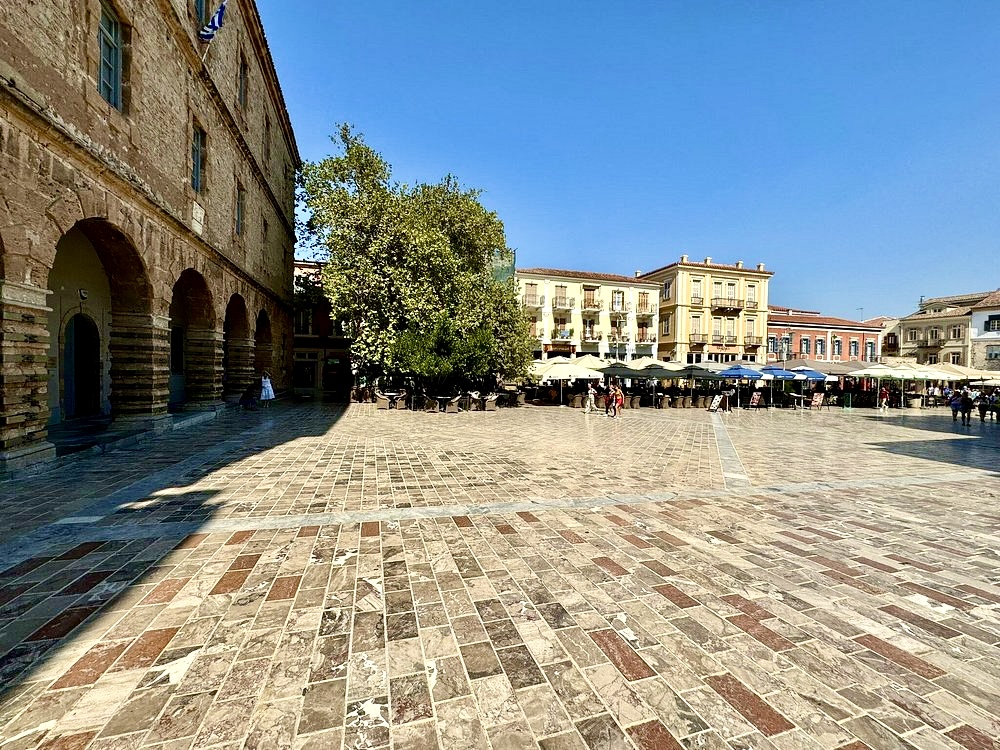
Syntagma Square
We happened to be in Nafplio March 24th–which is the day before their Greek Independence Day, a national holiday.
On March 25th, all Greeks commemorate the start of the 1821 Greek War of Independence against the Ottoman Empire and celebrate liberation from almost 400 years of Turkish rule. Children were patriotically waving Greek flags in the square, and flags were flying on homes and buildings all over Nafplio.
What was once the Venetian-built Naval Arsenal Warehouse is now the Archaeological Museum of Nafplio (1713) in Syntagma Square. Look for the “winged lion” above the door. It’s the symbol for Venice’s patron saint, the Apostle Mark.
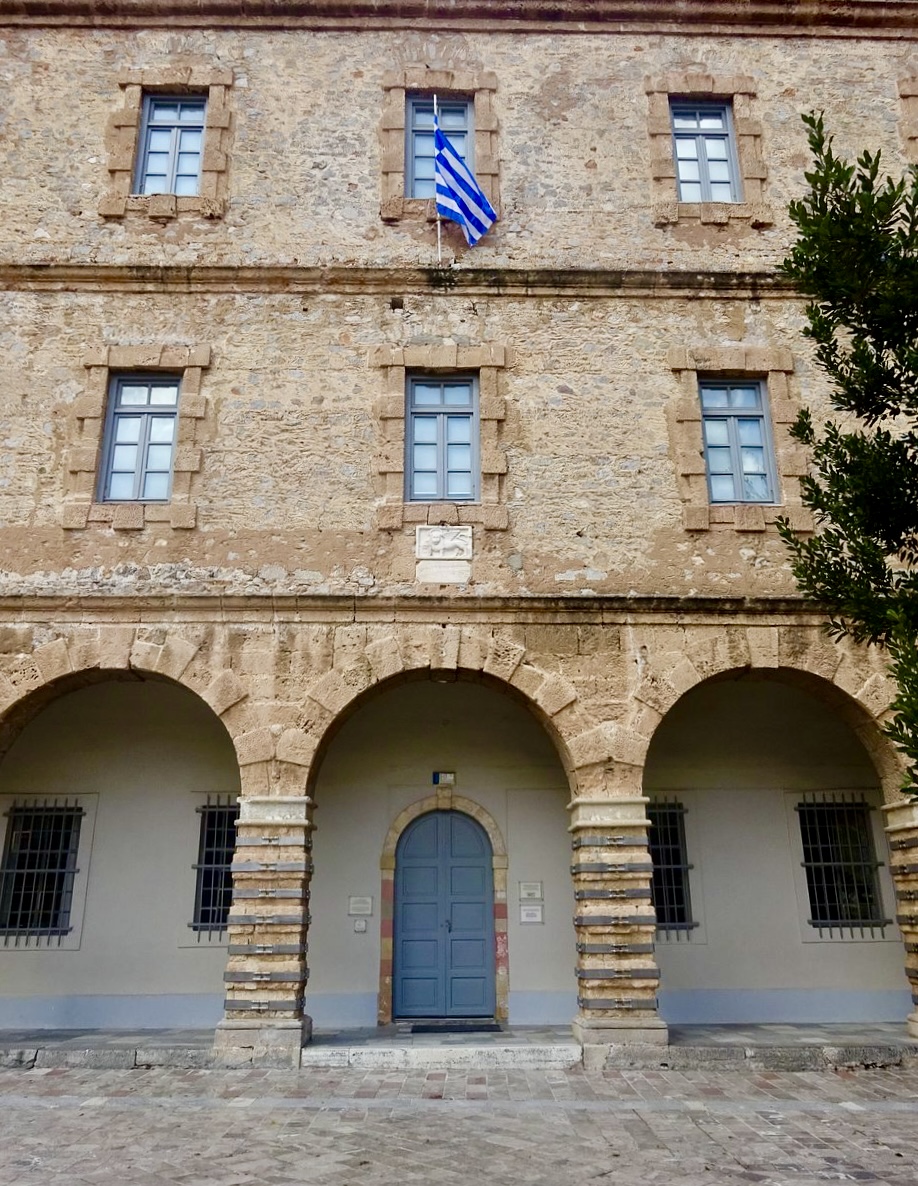
Exhibits are in English, and the museum has a good collection of both Prehistoric and Mycenaean civilization artifacts. Don’t miss the Dendra Panoply, the oldest surviving bronze suit of armor in all of Europe (found in a nearby Mycenaean tomb).
Ticket prices vary based on season, and the museum is closed on Tuesdays. https://archaeologicalmuseums.gr/en/museum/5df34af3deca5e2d79e8c1d2/archaeological-museum-of-nafplion
The Parliament Building
Rebellious Greeks secretly met in this building in the southwest corner of Syntagma Square. It was originally built in 1730 as a mosque during Nafplio’s second Turkish occupation.
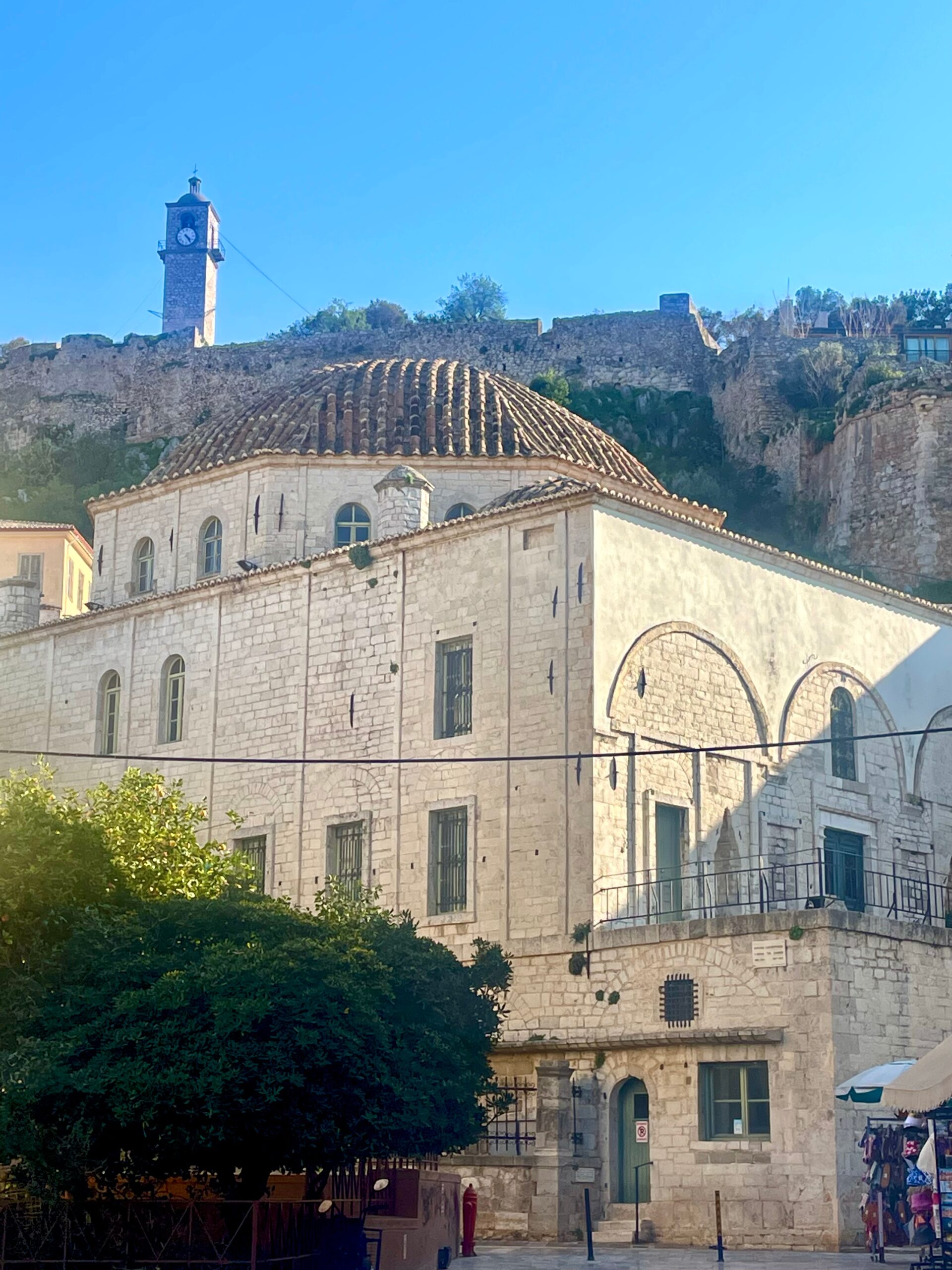
The Parliament Building was restored by the Greek Ministry of Culture, and it now serves as a conference and event center.
After liberation from the Turks, the building housed the Greek Parliament (1825-26). Through the centuries, it was a Greek school, a prison, a courthouse for trials, and even a public dance hall.
What Else Can You Find In the Old Town?
Nafplio’s Old Town is a labyrinth of narrow, winding cobblestone streets with gorgeous flowers and Bougainvillea trees (in late-March they were just beginning to bloom).
Its mansions, houses and buildings have a unique combination of Neoclassical, Venetian, Turkish and Greek architecture. Add to all that: charming boutiques, coffee shops, and cafes with plenty of hotels and inns.
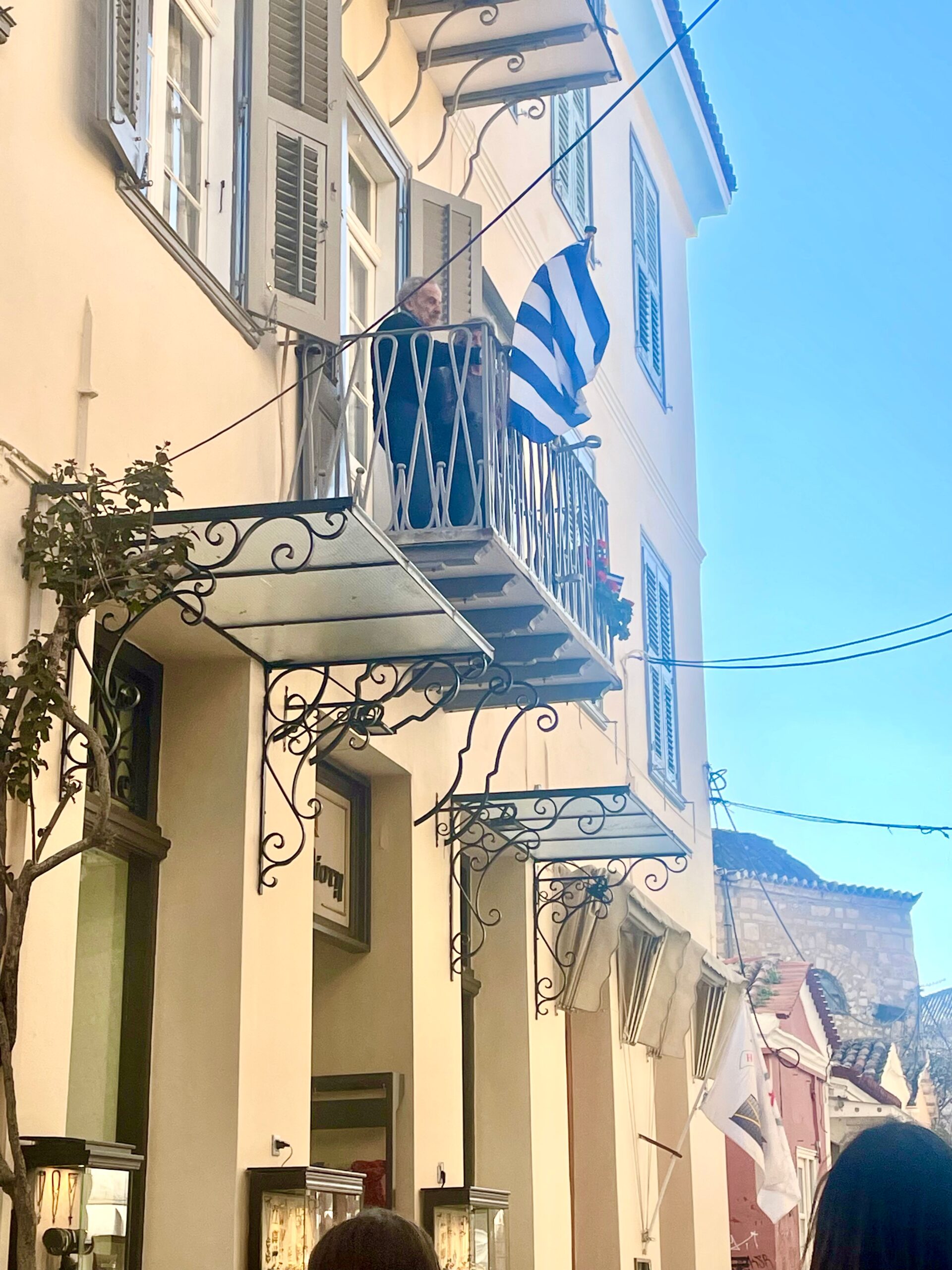
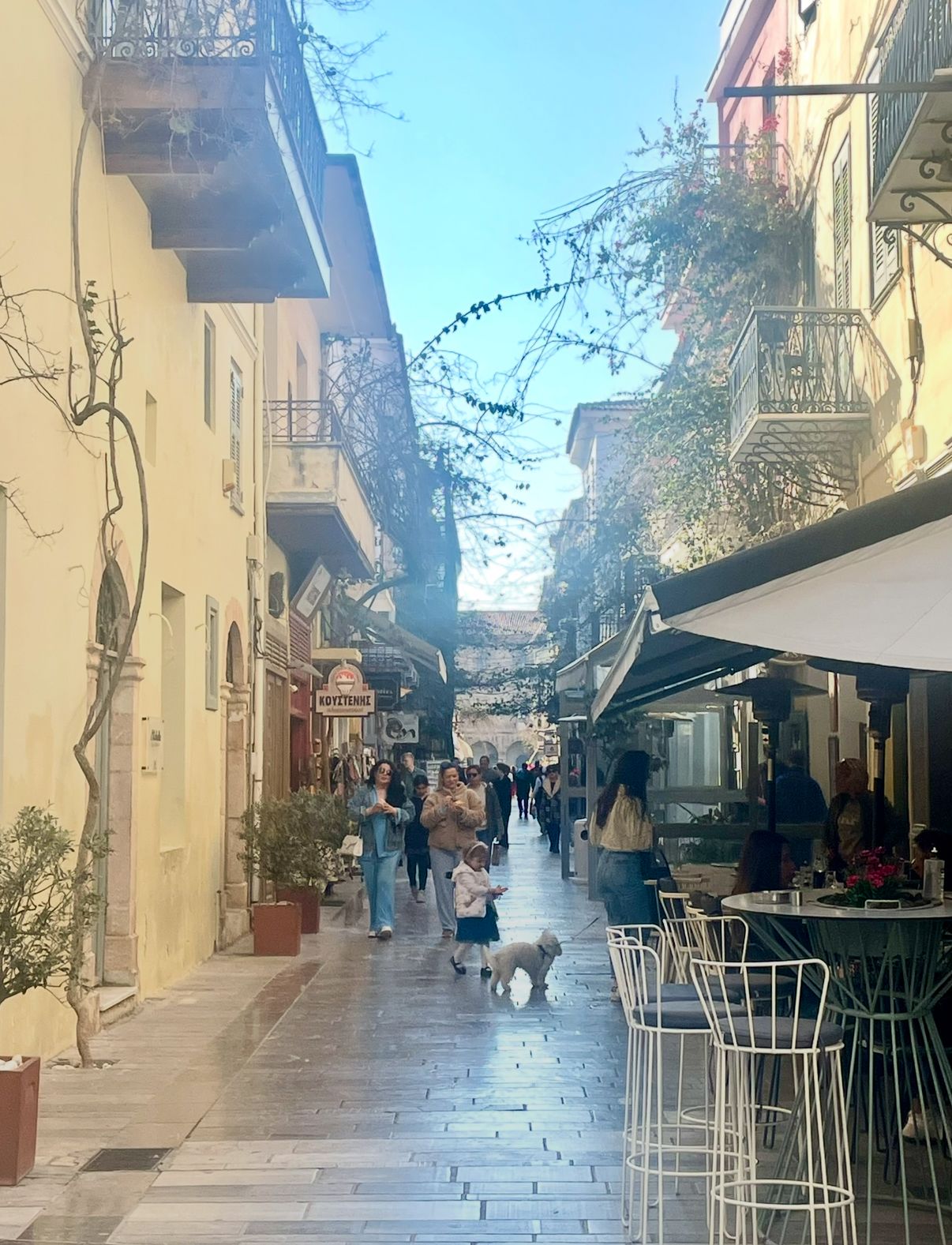
If you’re looking for the spot where Greece’s first president was assassinated, head to the Church of St. Spyridon (1702) in Old Town. President Ioannis Kapodistrias was stabbed and shot September 27, 1831 as he headed inside the basilica. Besides the pretty church, frescoes, ornate dome, and bell tower, you can find the surviving bullet holes near the church entrance.
One of the oldest and most beautiful Venetian churches in Nafplio is the Church of St. Mary Above All Saints (Church of Panagia). It’s a pilgrimage site for the martyred Saint Anastasius, and it’s known for its annual Good Friday procession through the narrow streets of the city.
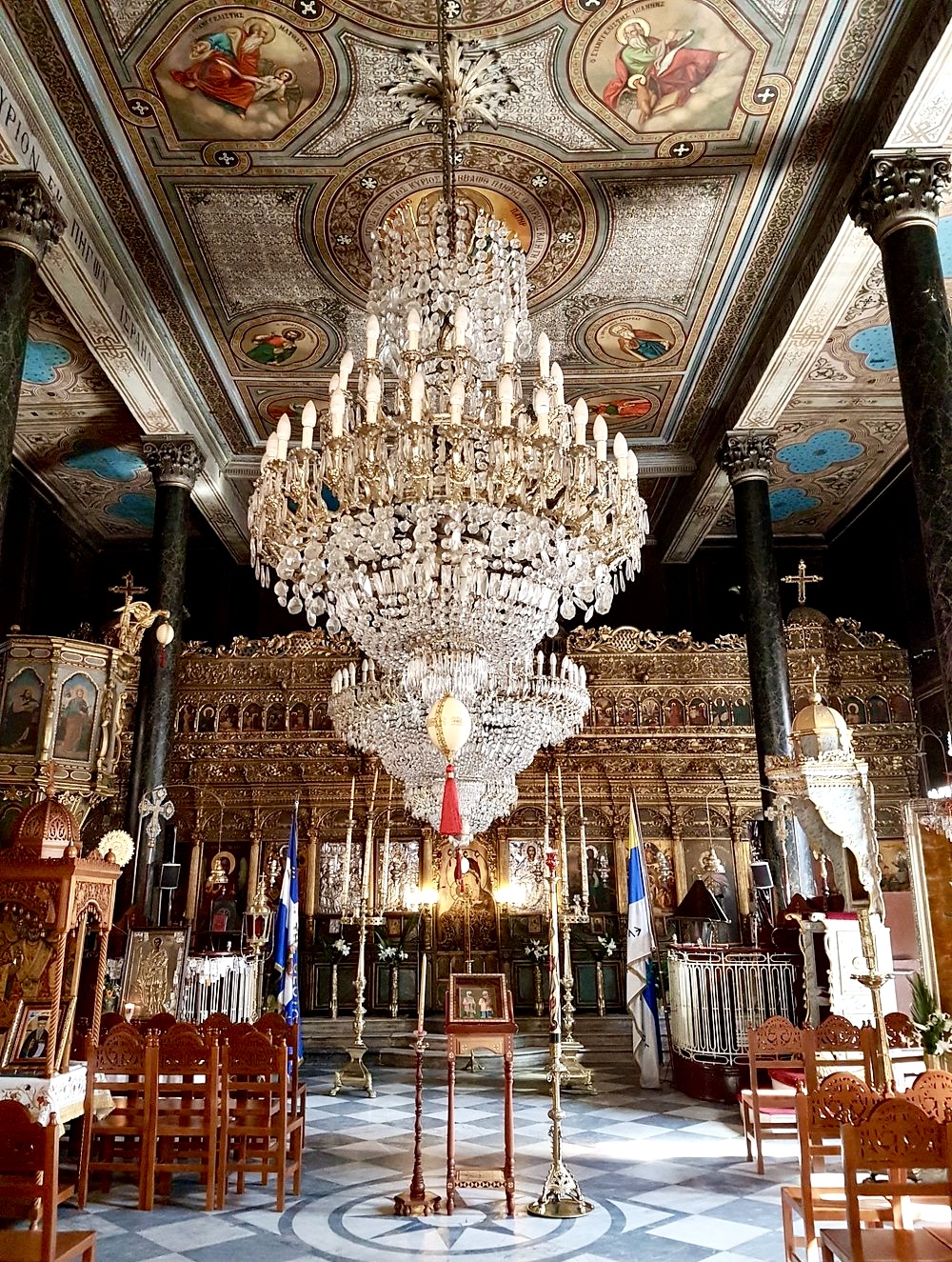
Church of St. Mary Above All Saints
In addition to the Archaeological Museum, Nafplio has a National Gallery Museum housed in a beautiful Neoclassical mansion. Its paintings and artwork focus on the Greek War of Independence (and descriptions are in English). http://www.culture.gr There’s also a Peloponnese Folklore Foundation Museum http://www.pli.gr and a Nafplio branch of the War Museum. http://www.warmuseum.gr
Ready to Explore?
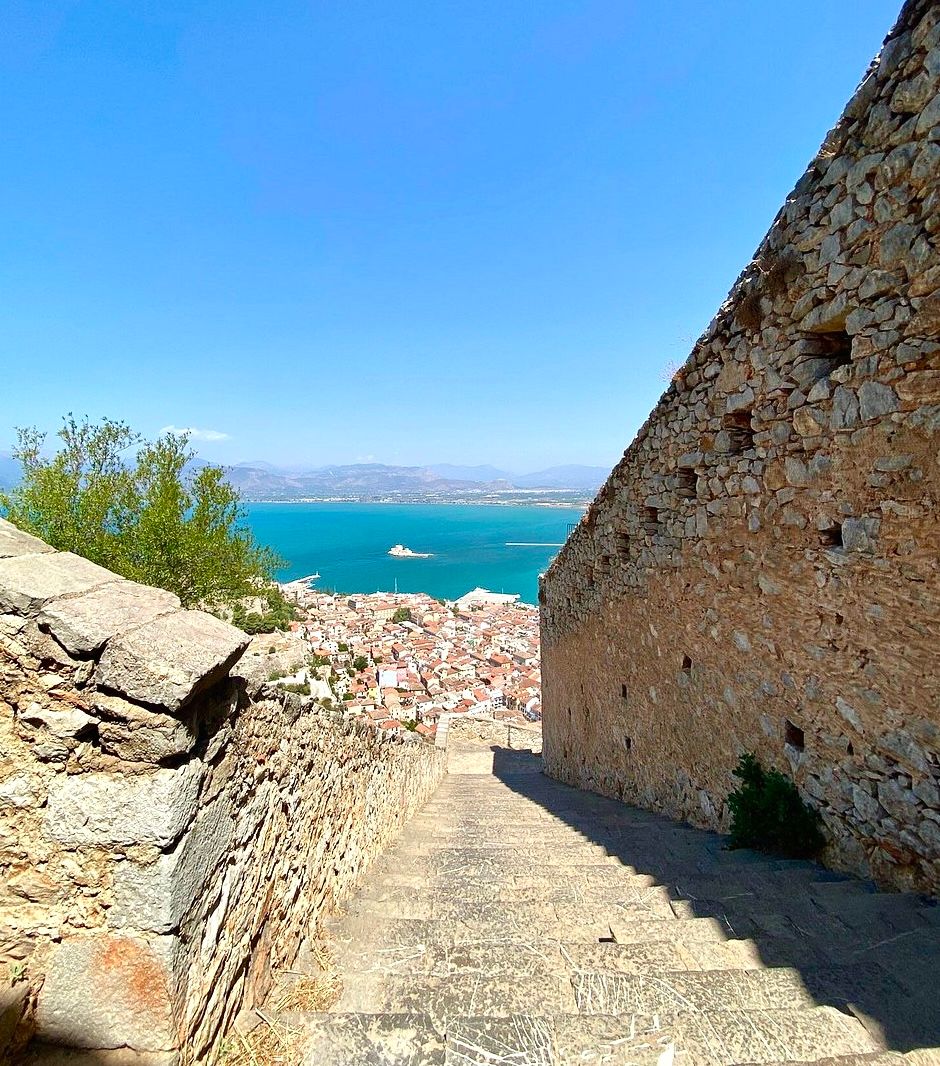
Nafplio is guarded by three castle fortresses: ancient Akronafplia, the Palamidi Fortress, and Bourtzi Castle (on an island in the harbor).
Akronafplia Fortress
Akronafplia is the oldest of the three castles, and its lower sections date back to the 3rd century BC. Today, the ancient fortress hovers over the Old Town and provides nice views of the Argolic Gulf, port, and city below.
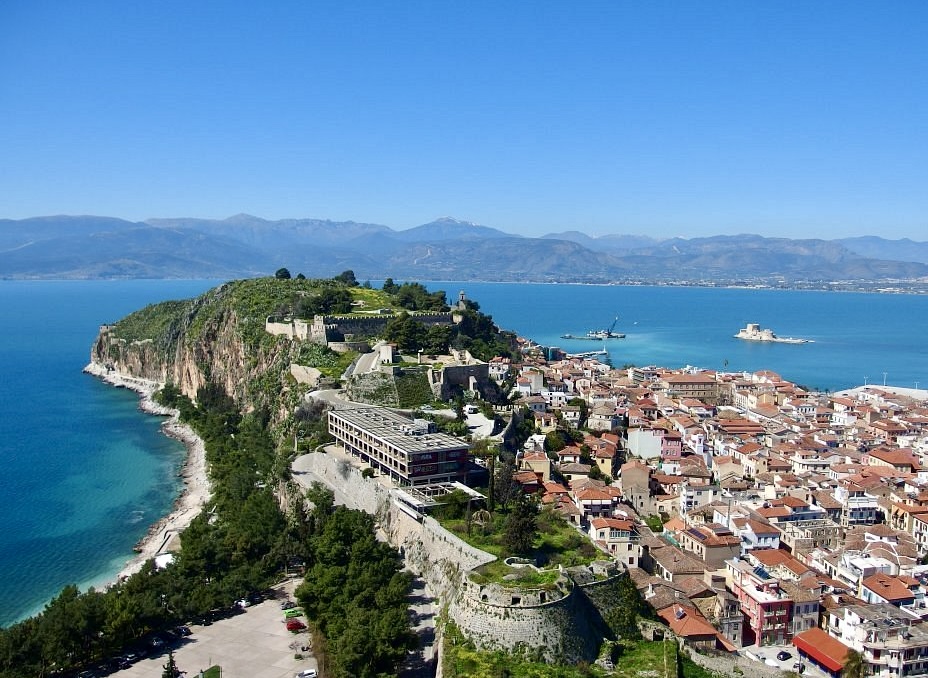
It was built on three levels, so if one part of the fortress was breached, the other levels could defend attackers. Byzantines, Venetians, Franks and Ottomans each added their own changes and architectural elements.
The Venetians and Franks added gates, bastions, and more walls to make it a stronghold. When the Turks captured Nafplio in 1715, they converted part of the fortress into a military hospital and barracks. From 1936 to 1956, Akronafplia was used as a Greek political prison.
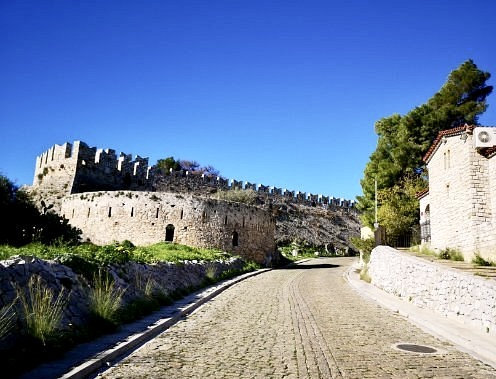
Heading up to Akronafplia Fortress
Visitors can see the Gate of Sagredo, the bastions (especially the Five Brothers Bastion), the military hospital, and explore historical castle walls.
TIP: Akronafplia is free to visit, and the views are worth the 10-to-15 minute climb to the top. Although parking is limited, you can drive up or take the elevator to the mountaintop Nafplia Palace Hotel from Politiko Nosokomiou Square.
Palamidi Fortress
For the best views of Nafplio, head way up to the Palamidi Fortress and citadel castle. It was famously named Palamidis after the mythical hero of the Trojan War in Homer’s epic novels. Palamidis was the son of Nafplios and the grandson of Poseidon.
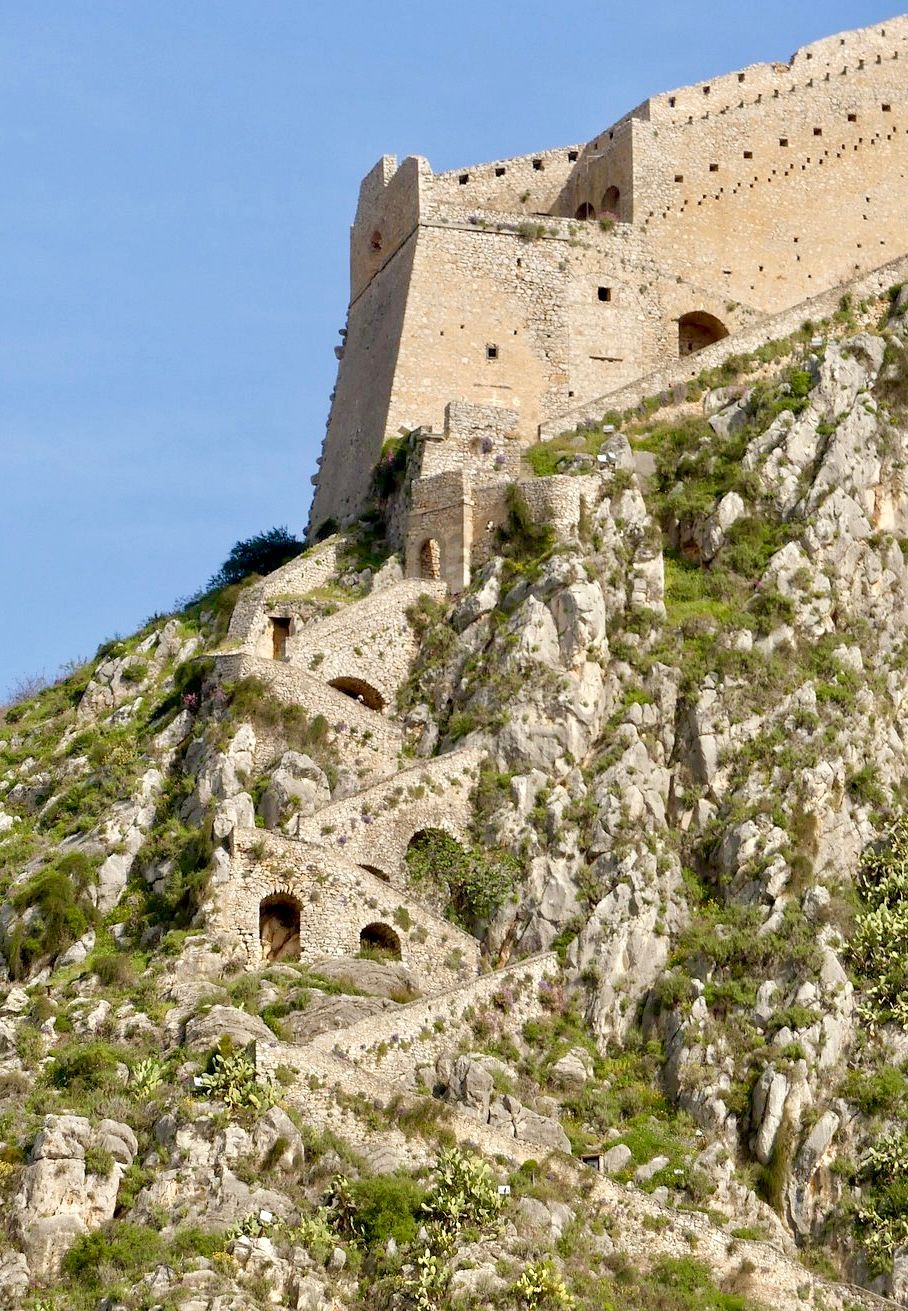
Palamidi Fortress – A climb with a view!
You can either climb the 999 steep, zigzag steps or drive to the top on the eastern side (follow signs for the St. Andrews Bastion). If you’re hiking up in the heat, take water!
TIP: Ticket prices are €8 (half price for students and seniors), and it’s free for anyone under the age of 18. Visitors can purchase tickets up top at the fortress entrance, but make sure it’s open before climbing!
The Venetians built this important and well-preserved castle between 1711 and 1714 on the highest hill overlooking Nafplio. It’s the largest fortress complex of its kind with eight independent bastions.
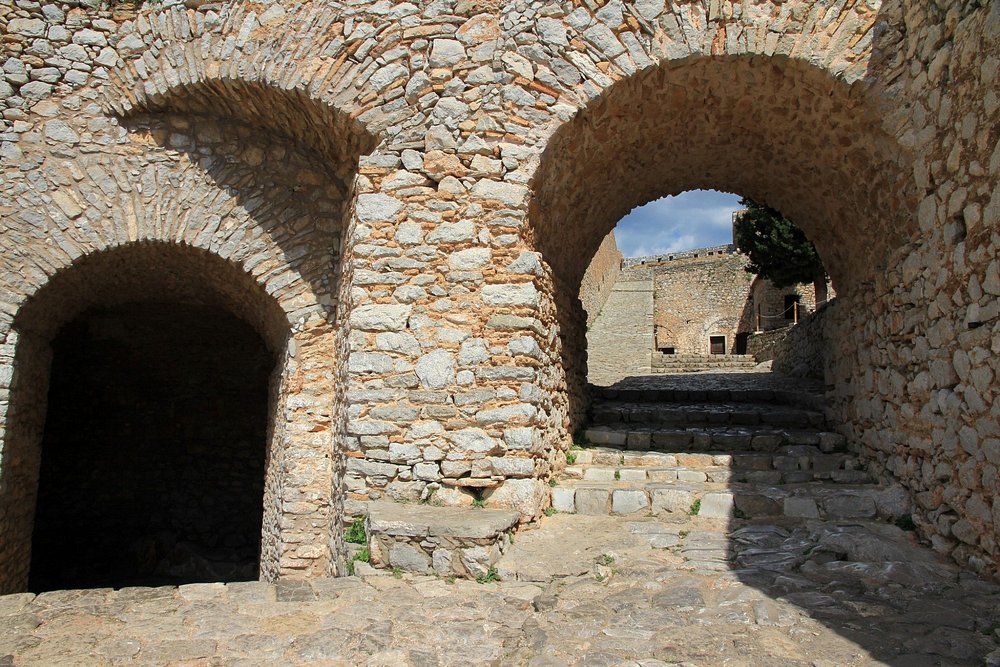
Eight bastions equaled eight layers of defense should a breach occur.
Be a kid! Explore the castle, well-preserved rampart walls, bastions, and chambers. Most bastions are now named after Greek warriors like Achilles, Leonidas, and Miltiades.
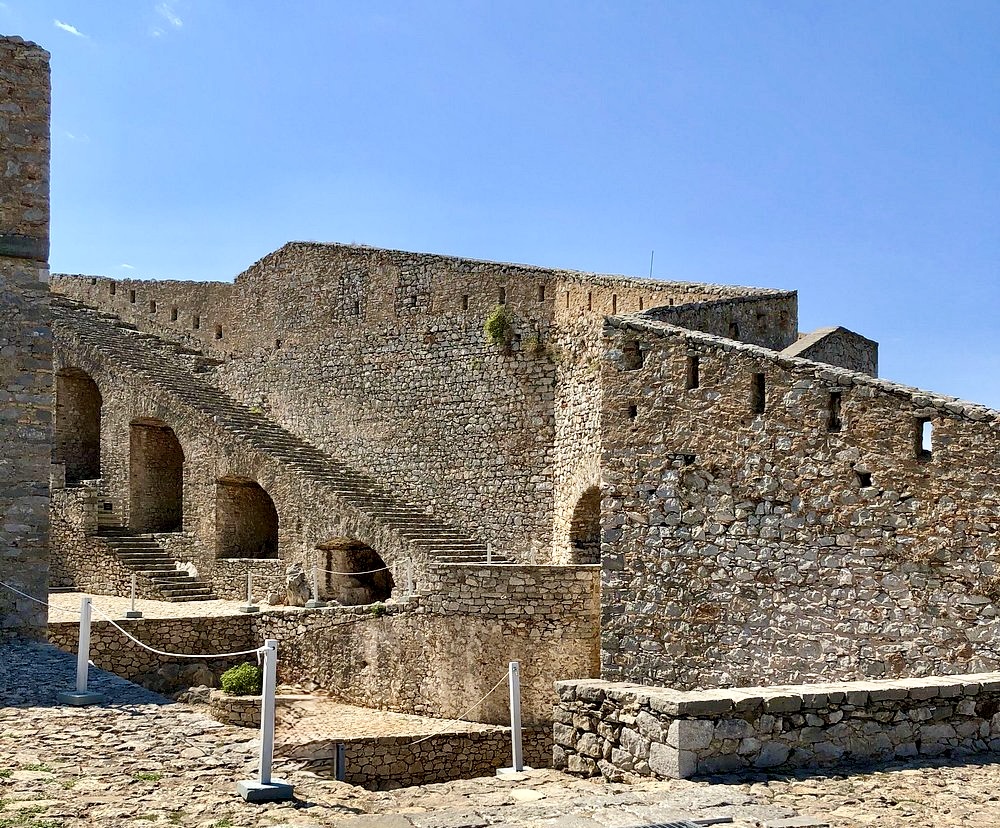
St. Andrews Bastion (Agios Andreas)
The best-preserved and most important bastion was St. Andrews. It served as command headquarters. Visitors can see the prison cell of Theodoros Kolokotronis (the Greek revolutionist and hero) who was imprisoned in the Miltiades Bastion.
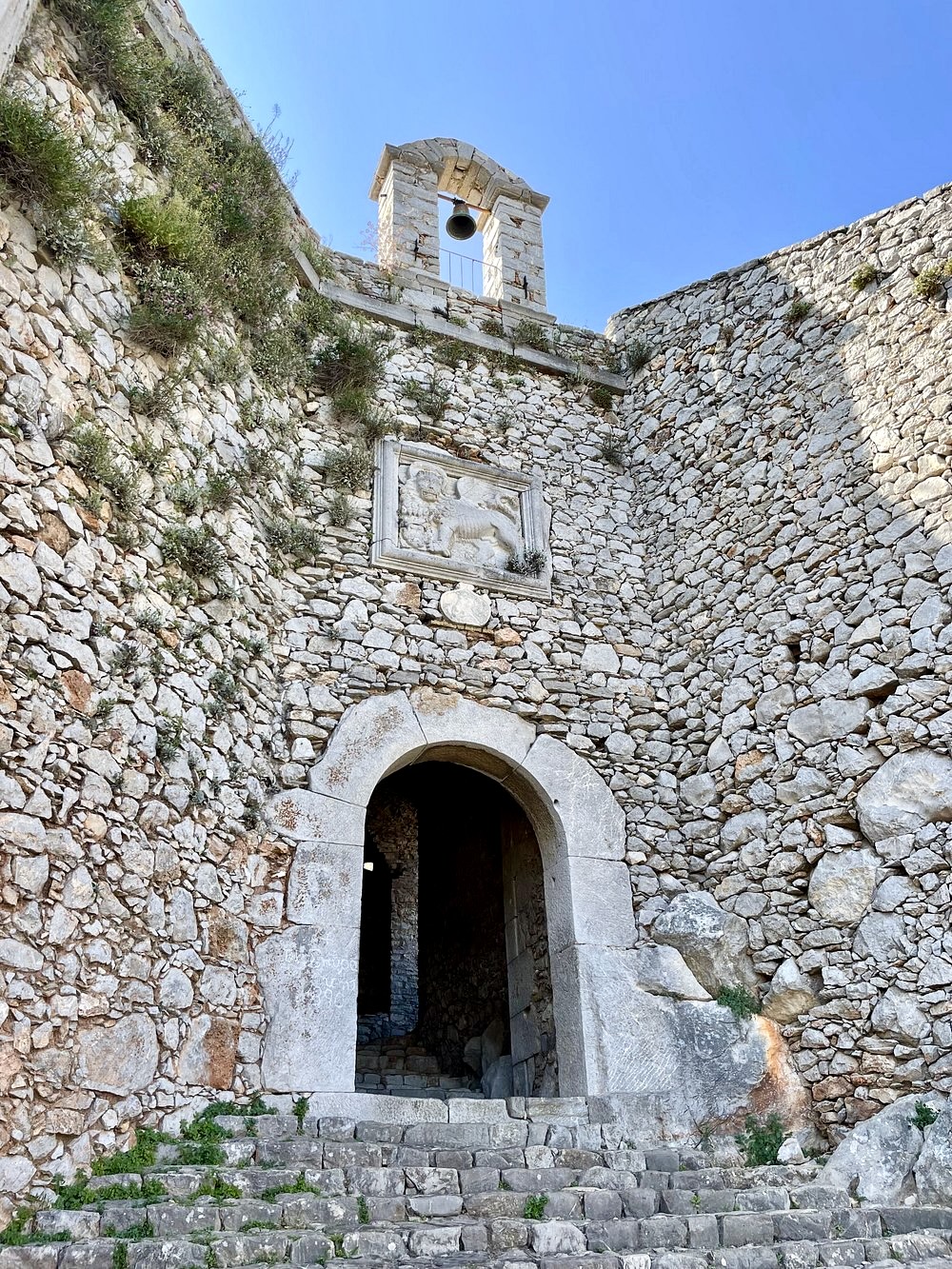
The tiny chapel of Saint Andrews, now in ruins.
Palamidi’s weakest point was the Achilles Bastion (pretty sure the name is intentional). From the lowest point of the stronghold, the Ottomans captured the fortress in 1715, and the Greek independent forces later drove out the Ottomans at that spot in 1822.
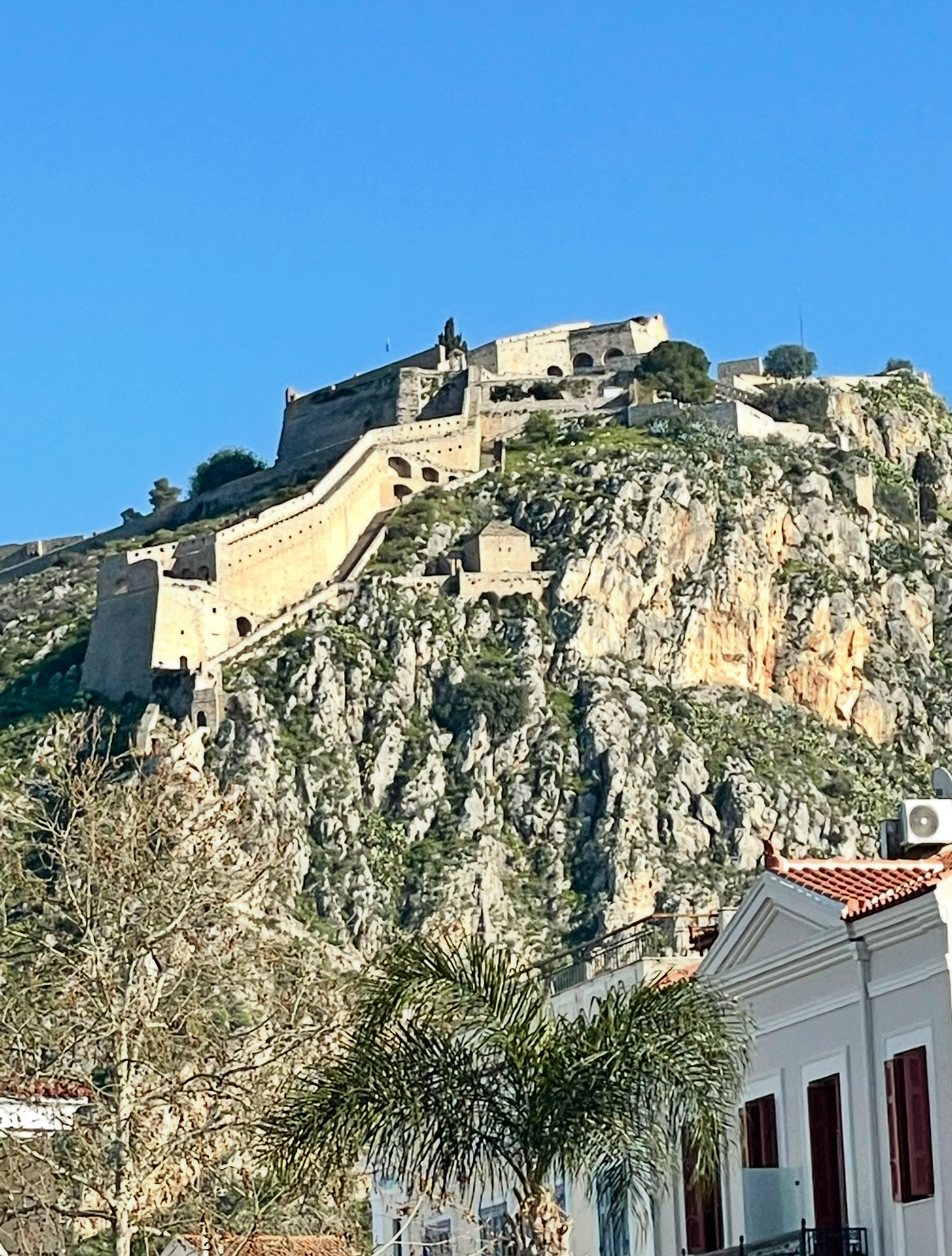
The Greeks claimed Palamidi last in the revolution!
Bourtzi Fortress
Bourtzi Castle is the island fortress in the Nafplio harbor overlooking the entrance to the port. It was originally built in 1473 by the Italian engineer, Gambelo, on what locals call St. Theodore’s Island.
In 1502, the Venetians fortified it with defensive walls and cannons. At one time, a giant chain was connected from Bourtzi to the Acronafplia Castle in an attempt to prevent pirate ships and invaders from entering the port.
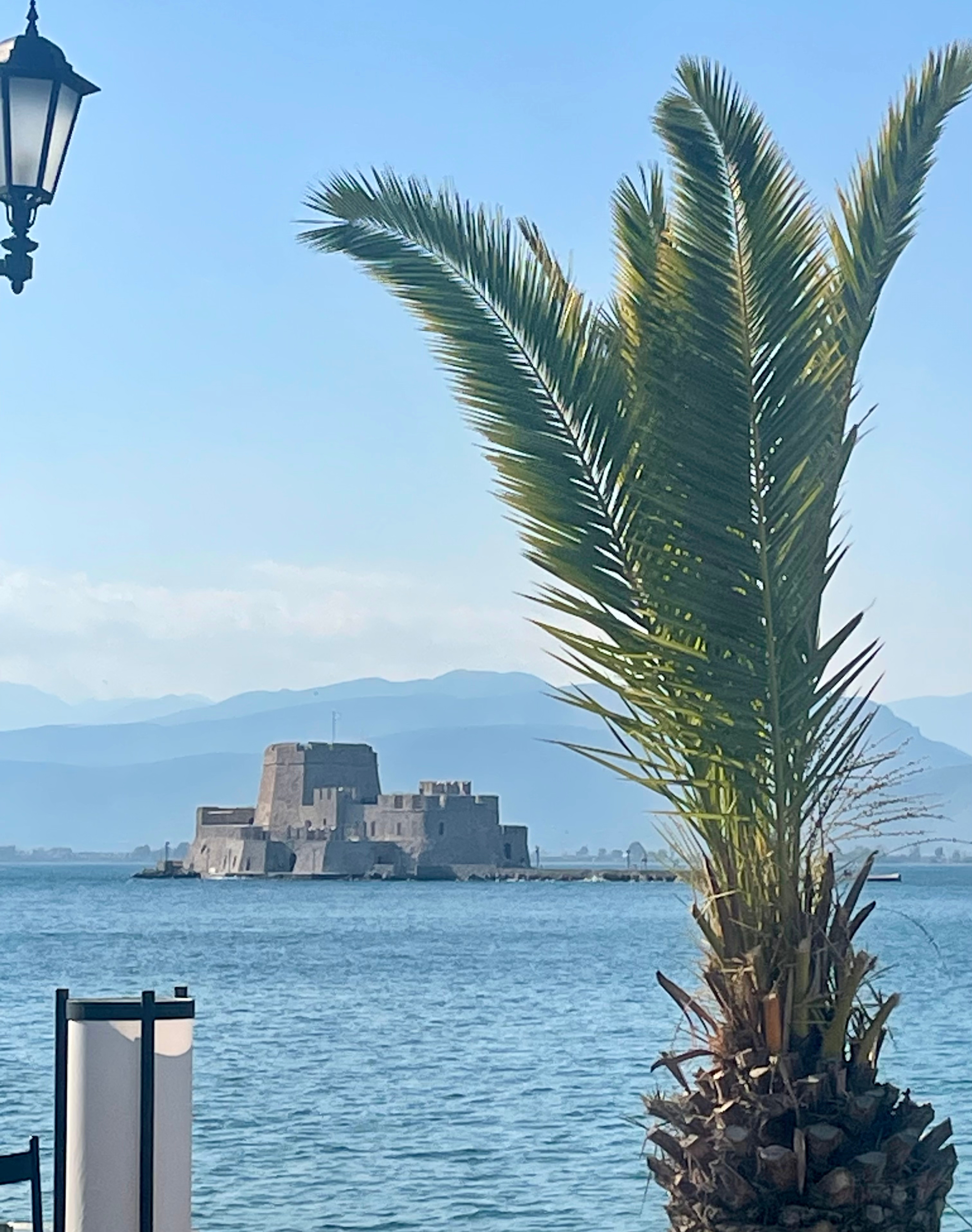
Bourtzi has been everything from a guillotine site for executions, the home of the Greek government, and it served as the Greek National Tourist Organization. From 1960-70, the fortress was a luxury hotel and restaurant. In 2023, it opened as a cultural historical monument.
TIP: Visitors can pay €5 to take a boat to the site, then €7 (less for children) to visit the castle. Make sure it’s open the day you’d like to visit, and check opening/closing times. We found some Greek timetables were just a suggestion.
The Beach is Calling. . . . .
Whether you like sandy beaches, rocky beaches, family-friendly, or hidden beaches, Nafplio has it all! Here are two favorites among many:
Arvanitia Beach is small and pebbled (not sandy), but it has the “blue flag” award for beautiful, clear, and clean water. This beach has sunbeds, umbrellas, restrooms and a shower, plus options for snacks and drinks. It’s a short five-minute walk from town on the nature pathway. If you drive: there’s free parking at the entrance.
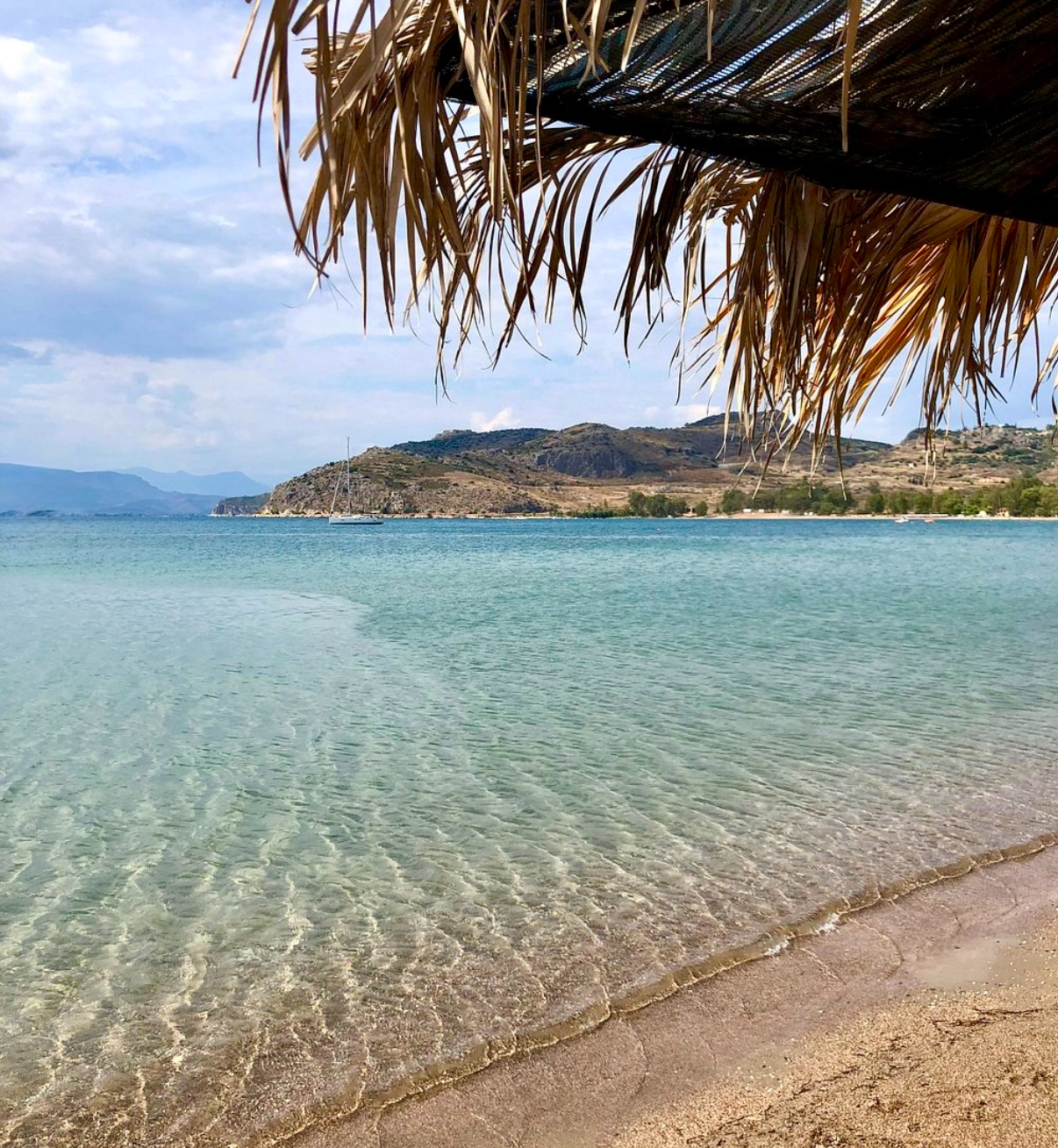
Karathona Beach is Nafplio’s longest beach and also has the “blue flag” award. The sandy beach comes complete with palm trees, beach chairs and umbrellas, plus a beach bar and food tavernas. Karathona Beach is a little over two miles from town. You can drive, ride the bus, or take the pretty Arvanitia-Karathona walking path.
Nafplio's Food Scene
Not only is Nafplio known for its culinary delights, it’s just 30 minutes from Nemea — the largest wine-producing region in Southern Greece.
Eating in Nafplio is an experience: a blend of traditional Greek flavors, fresh fish, seafood, and Peloponnesian hospitality. Along the waterfront, restaurants highlight the day’s catch (grilled octopus, shrimp, and fish) paired with local wines and ouzo. Tavernas tucked into narrow streets and plazas serve Greek classics, and bakeries tempt visitors with lots of goodies!
Following a long morning exploring ancient Corinth, we arrived in Nafplio hungry! After checking out our options, we chose Bounos Psarosavouras Taverna with a sea view.

All four of us ordered a variety of dishes for sampling; my choice was the shrimp with fresh pasta!
Our group was invited into the kitchen to choose our fresh (still alive) catch-of-the-day! The seafood was delicious, and the helpful staff suggested perfect local wines, deboned our fish, and took care of us well. I highly suggest this gem in Nafplio!
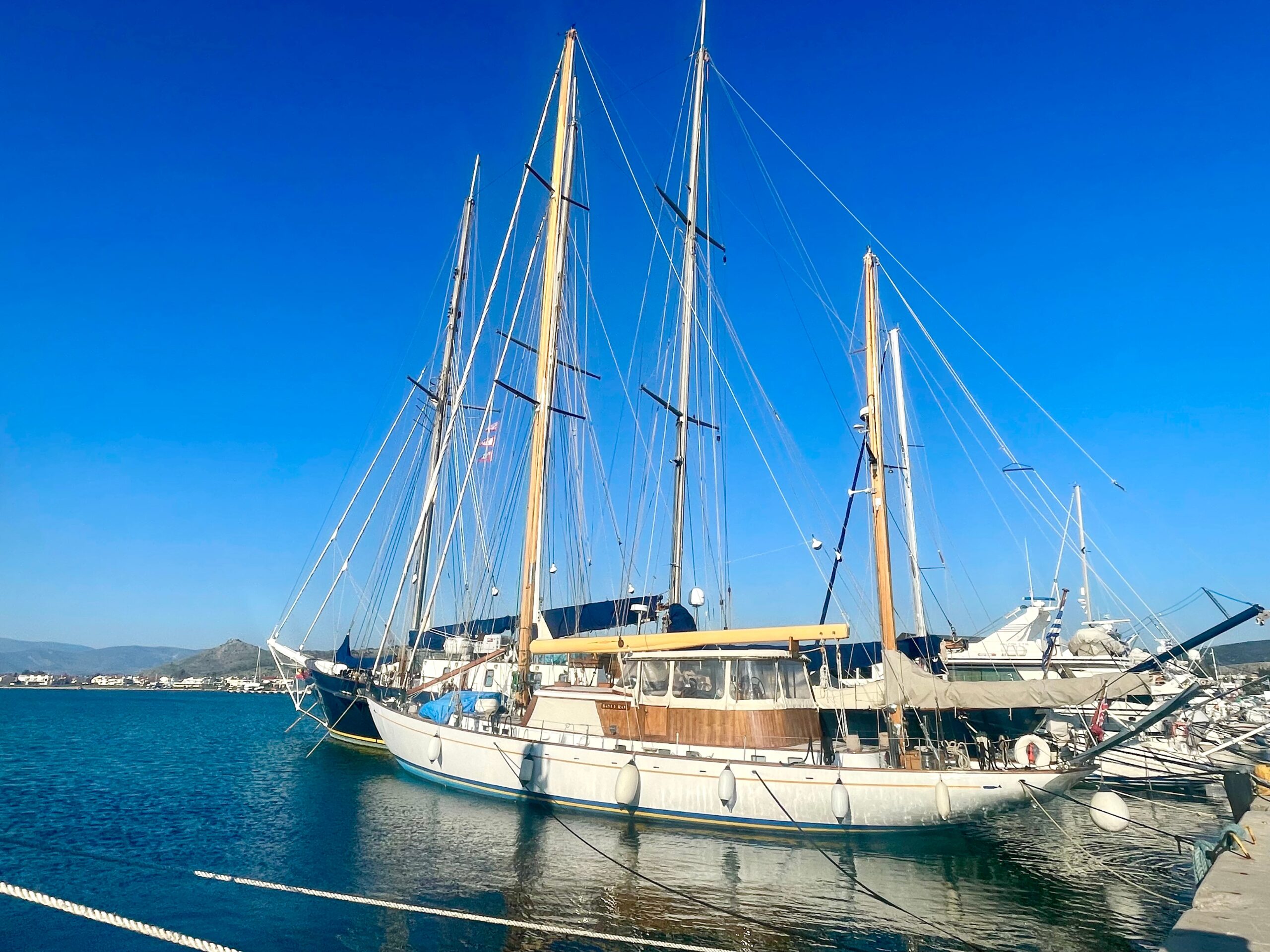
Nafplio Wrap-up and What's Next?
Don’t forget: if you rent a car anywhere in Greece, you’ll need to get an International Driver’s Permit (IDP) before you go. Our permits were purchased at AAA Travel. http://www.aaa.com
Leaving Nafplio felt more like a promise to return and less like saying “goodbye.” It was our final destination after an island hop to Santorini and almost two weeks–and over 1650 miles–of Greece mainland traveling. We were sad to drive back to Athens for our flight home the next morning. I’m so glad we added Nafplio to our Greek itinerary!
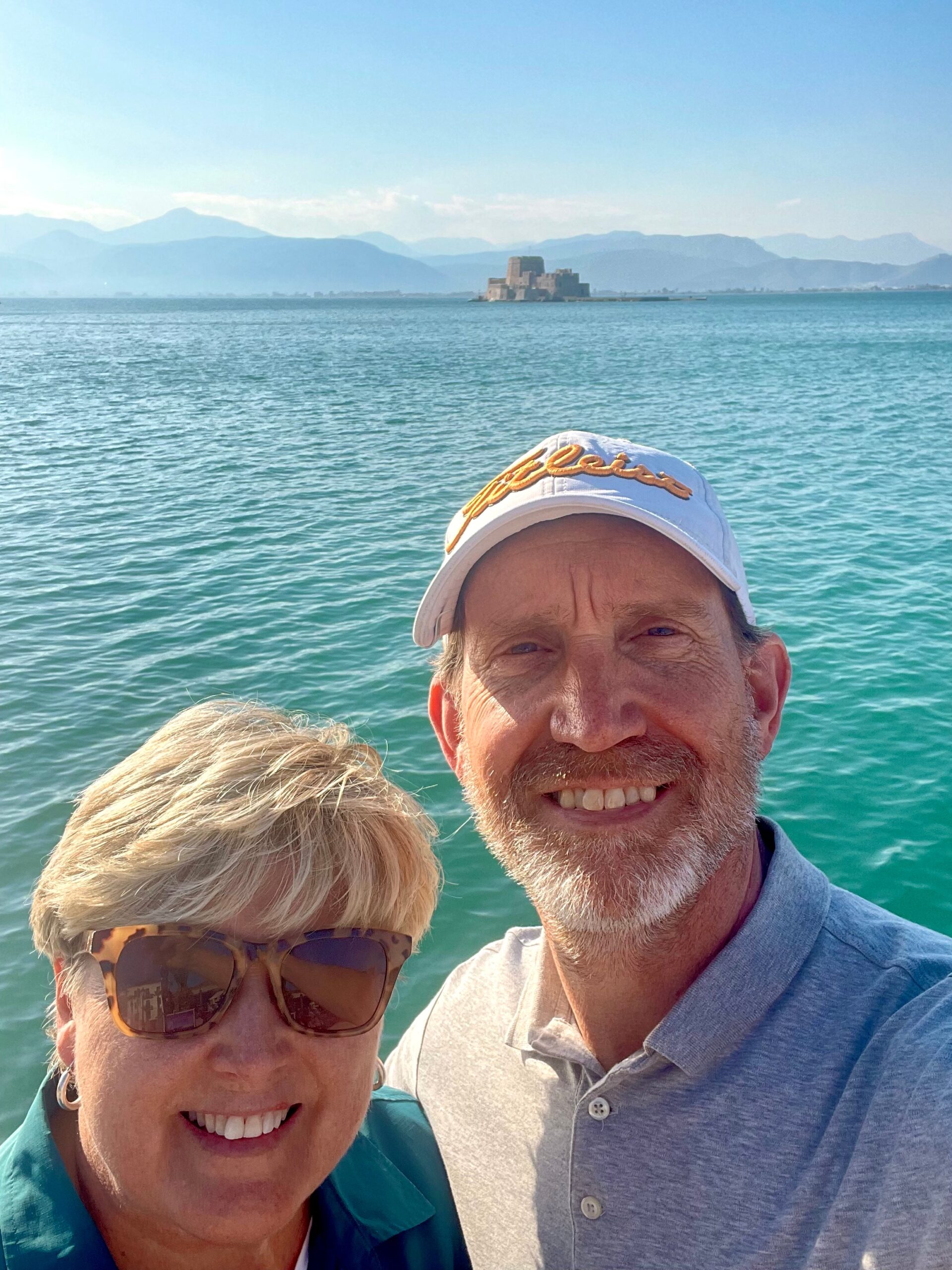
What’s next? A Greece wrap-up and a new series! So YOU TELL ME:
Should it be Paris and side trips all over France, Belgium and Monaco?
Or London and Scotland and amazing adventures in Great Britain?
A Rhine River Cruise through Switzerland, Germany, France and the Netherlands?
Or the Holy Lands of Israel and Jordan?
Let me know what you’d like to see next!
Until then, keep exploring!
Check out my other Greece travel blogs:
Echoes of Corinth, Greece – A Great Ancient Superpower
Modern Thessaloniki – A Melting Pot of Ancient Civilizations
A Day Trip to Ancient Philippi, Greece
Meteora Monasteries – A Climb to the Top!
Magnificent Meteora – Castles in the Clouds
Delphi, Greece – It’s Still a Mystery
Olympia, Greece – The Birthplace of the Olympics
Athens, Greece – The Acropolis
Santorini, Greece – Off the Beaten Path
For all travel blogs, visit my blogsite: https://traveltipsbytami.com
A wonderful spot to end our trip. The town is beautiful and the seaside invites you to a slower pace. The sunset was amazing and the seafood was fresh from the boats in the harbor. Be sure to visit Nafplio while in Greece.
Next I’d love to read more about a Rhine River Cruise through Switzerland, Germany, France and the Netherlands!! Love these.
Thanks! Loved this trip and can’t wait to blog about it!